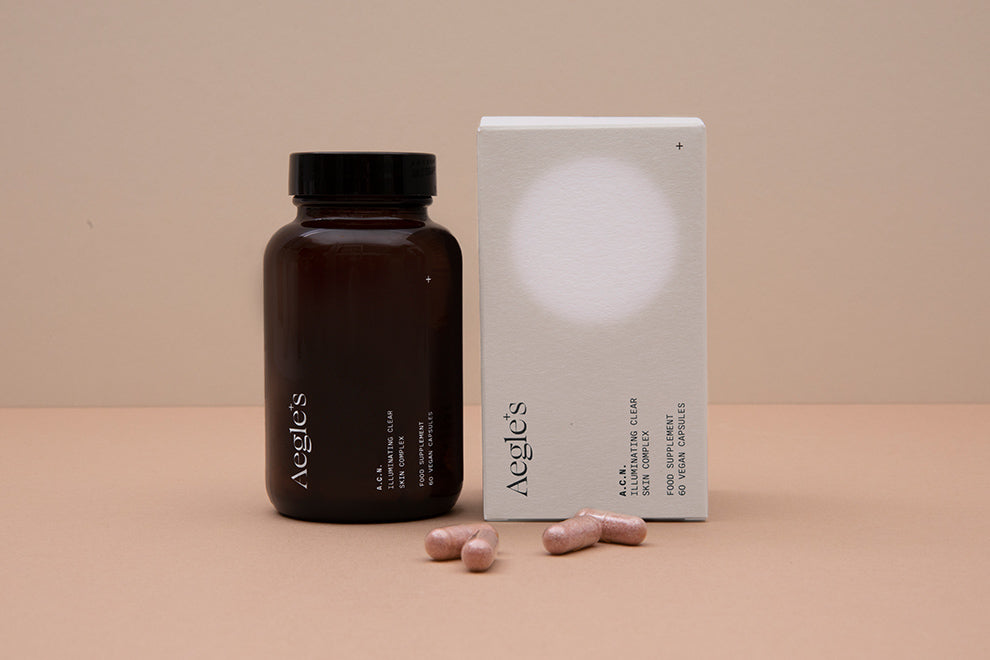

You may know that you’re acne-prone, but do you know why you’re getting acne?
Women experience acne more or less between the ages of puberty and menopause, with a gradual easing off of the number of blemishes from around the age of 35.
This is a clear indication that acne has a close relationship with both our age and our hormonal system. But which hormones in particular are to blame? And why does age matter?
How acne is formed
Acne begins with the production of an oil called sebum, within the sebaceous glands near the surface of the skin.
Sebum is what helps to keep our skin moist, protected and looking young. But when the sebum gets clogged in a hair follicle and cannot reach the surface of the skin, acne can form.
Anything that can overstimulate this production of sebum will increase the chances of a hair follicle becoming clogged, and then potentially resulting in acne. If the clogged hair follicle is open to the skin, it forms a blackhead. If it is close to the surface of the skin, it bulges outwards and forms a whitehead.
When acne bacteria contaminates the whitehead or blackhead, an acne inflammation forms.
Our skin produces the most sebum between 15-35 years of age, which is why it is more common to experience acne in this age range.
Our hormonal system can both increase and decrease sebum production. For example, one week before a woman’s menstrual cycle her sebum production increases. This is why many women typically experience acne breakouts before their cycle.
Estrogen dominance
Estrogen dominance is one of the leading causes of acne in women. It occurs when a woman’s estrogen to progesterone ratio is too high. This is either when her levels of estrogen are too high, and/or her progesterone is too low.
Progesterone rises during the second half of a woman’s cycle for about five days, before dropping again just before menstruation. Within the same time frame of a woman’s cycle, her sebum production increases with an increase of circulating insulin in the body. Healthy progesterone levels reduce this sebum production.
So a woman with a healthy estrogen to progesterone ratio is less likely to experience excess sebum production and therefore premenstrual acne. Simply because she has sufficient levels of sebum reducing progesterone.
Many factors can cause estrogen dominance including:
- Obesity and poor diet
- Low levels of healthy fats in the diet
- Chronic stress
- Hormonal birth control
- Hypothyroidism
- Hashimoto’s disease
- Gut dysbiosis
- Medications
- Genetics
- Copper toxicity
- Polycystic ovary syndrome
Excess androgens
When a woman’s acne is not cyclic, meaning that it does not appear at roughly the same time each month, then it is more likely due to excess androgens.
Androgens are male sex hormones that are also present in the female body. Excess androgens can cause an increase in the production of sebum in the hair follicles of the skin, and therefore acne.
The androgens in particular that can cause acne when they are in excess are; testosterone, dihydrotestosterone (DHT), androstenedione and dehydroepiandrosterone sulfate (DHEA-S).
A number of factors can cause androgen excess including, chronic inflammation, genetics, hypothyroidism and blood-sugar imbalance.
Blood-sugar imbalance
Both a diet too high in sugars and insulin resistance, can cause an excess of insulin in the bloodstream, which can raise the levels of acne-causing dihydrotestosterone.
Excess insulin can also cause an increase in Insulin-like Growth Factor-1, which promotes the overproduction of sebum and skin cell growth too, both leading to clogged skin and acne.
Most healthy women experience temporary insulin resistance in the days leading up to menstruation. This is why cravings for carbohydrates and sugars are common and why some women experience more acne during this time.
Poor gut health
A healthy gut is essential for the regulation of healthy hormones.
An imbalance in the bacteria in the gut is often the root cause of the hormonal imbalances that cause acne.
Hormonal birth control
Using a form of hormonal birth control such as the birth control pill, hormone releasing implant or IUD, can either help to clear or cause acne. This depends on the hormonal makeup of the pharmaceutical or device, and the constitution of the woman using it.
Most women will not experience problems whilst on birth control. However, it is especially common for women coming off hormonal birth control to experience up to severe acne, roughly three months after coming off the pill or removing a hormone releasing IUD or implant.
In this case, the cause of the acne can be low progesterone, estrogen dominance, excess “foreign” estrogens (xenoestrogens), as well as a depletion of essential vitamins, minerals and healthy gut flora.
Chronic inflammation
Acne is often referred to as an inflammatory disease, so it’s no surprise that chronic inflammation in the body is one of the leading causes of acne.
Acute inflammation is a good and necessary function of the body to heal itself from injury or disease. However, when the inflammation becomes chronic, it can contribute to imbalances and health problems in the body, such as acne.
Causes of chronic inflammation in the body include:
Skincare
Whilst skincare can cause acne, this type of acne looks very different to the inflammations that are caused by internal imbalances. Skincare acne is mild and can be inflammatory, but it is not cystic.
This type of acne is caused by an ingredient in a skincare product contributing to the clogging of sebum within the hair follicle. Some skin types are more prone to clogging which is why not everyone will react the same way to the same ingredients or products.
What is the cause of your acne?
If you have acne-prone skin, then your acne may have more than one cause. For example, it is very common for women to have hormone imbalances, elevated blood-sugar levels and poor gut health.

Start your journey to heal your skin now.
- Contains ingredients clinically proven to improve blemishes and skin radiance.
- Formulated by one of the world's leading skin practitioners.
- The only supplement that works for the three main causes of blemishes, blackheads and oily skin.






